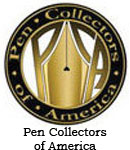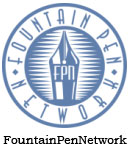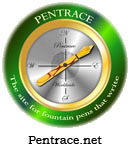Sheaffer Glideriter 1965-1968
by Jim Mamoulides, July 24, 2004, updated October 30, 2004 and December 31, 2012
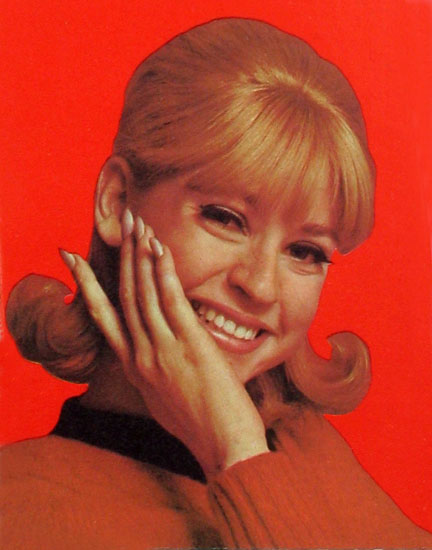
Why is this woman smiling?
It's easy to take everyday things for granted, especially consumables. Many people think nothing of the workings of the throwaway ballpoint. It might surprise them to know that early commercial ballpoints of the 1940s were expensive, top of the line pens that directly competed with top line fountain pens. Throwaway pens really didn't become commonplace until the late 1950s.
The idea of the throwaway ink cartridge had fully taken hold by 1959, and between the BIC ballpoint and the cartridge fountain pen, the 1960s were set as a decade of disposable innovation. Would the cartridge pen in its many forms, fountain and ballpoint, survive or would it be replaced by the cheaper throwaway ballpoints?
Pen makers didn't stop with only two forms of ink writing. Sheaffer and Parker, for example, continued to look at the market and create new ways to put ink on paper. Today, we not only have fountain pens and ballpoints, but also rollerball pens, gel pens, erasable ink pens, stylographic pens, dip pens, and fiber tip pens, much of that innovation beginning in the 1960s. I've managed to leave out quills and brushes as they generally aren't considered fountain or cartridge pens, although there was at least one attempt to make a brush type fountain pen, the very wacky Vaporite Brush Pen.
The fun new way to write
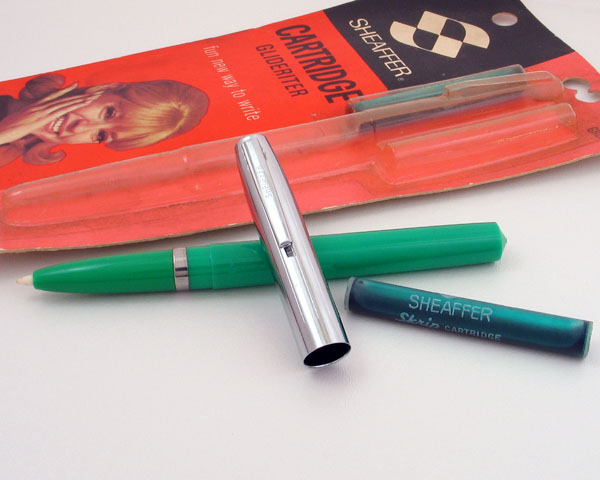
Sheaffer Glideriter Cartridge Pen Green c1965-1968
Sheaffer's foray into fiber tip pens began in 1965 with the Stylpoint Writer marker pen, a plastic fiber tipped pen that used the same replaceable Skrip ink cartridges as Sheaffer cartridge fountain pens. The Stylpoint blister packaging declared, "Writes young, bold, alive" and "Exciting new way to write." Sheaffer renamed this pen the Cartridge Glideriter in late 1965, as evidenced by the name change in Christmas advertising. The pen was a standard Cartridge Pen model with a new type of section, filled with a porous plastic fiber material that extends from the opening in the section nipple through the section to the tip.
The tip looks like most fiber tip pens, a blunt cone sticking out of a hole in the tip of the section. The cleverness of the pen is that it uses replaceable ink cartridges. It's a fiber tip pen that never runs out! These early fiber tip pens did not have any reinforcement for the tip, so hard writing will distort the shape of the tip and eventually wear it out. The very similar non-refillable Smoothie was also introduced in 1965, and is virtually identical to the Cartridge Glideriter except for a larger, broader tip.
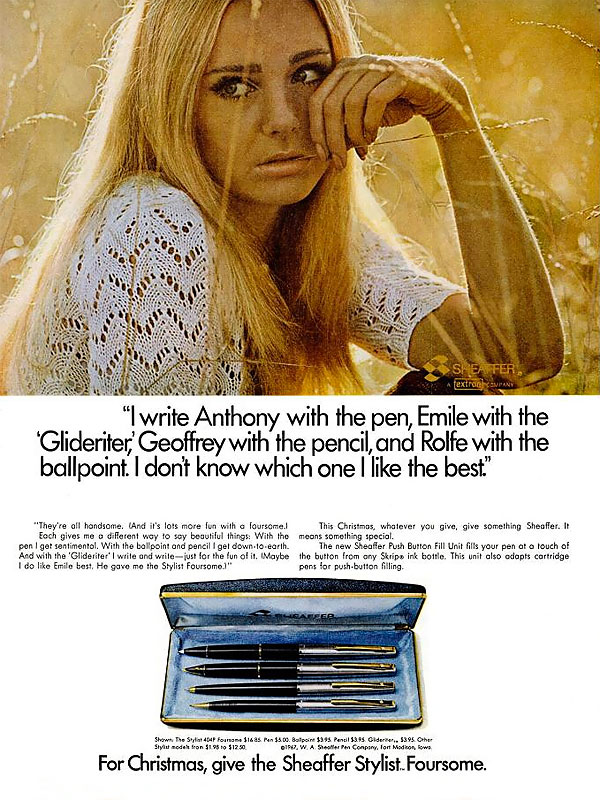
Sheaffer didn't apply the Glideriter brand only to cartridge and throw away pens. In 1966, Sheaffer used "Glideriter" as a brand for three fiber tip pens, the TwinWell Glideriter, the Cartridge Glideriter, and the Stylist Glideriter. Much as "Flair" later became synonymous with fiber tip pens, Sheaffer must have been trying to establish "Glideriter" as the first to mind leader in fiber tip brand names.
When the Stylist line was introduced in 1966, one of the four writing modes offered was a Glideriter. This brought the fiber tip pen upscale to the gift pen market. The tips were replaceable with new screw-in units. Unfortunately, the Stylist is one of the least loved pen lines in the Sheaffer pantheon. The third Glideriter was the TwinWell, which had been introduced in 1965, but renamed the TwinWell Glideriter in order to unify the Sheaffer fiber tip pens under one brand.
The Stylist was the first new pen design released after Textron bought Sheaffer. The original Stylist fountain pen had a screw in nib unit mounted with a two-way V shaped nib similar to the later Parker 180 design. The Stylist line is also notable as being the principle product line where the familiar Sheaffer White Dot was replaced with a white "S", appearing at the top of the Stylist clip. Stylist fountain pens are not noted for being great writers and collectors often shun them. They languish in the low value basement of collectible Sheaffer pens. The line, and the Glideriter model in it, was dropped after only a few years. Sheaffer returned to familiar designs in 1969, turning the page on the Stylist and the Glideriter.
Parker, probably not wanting to be left behind, also introduced a refillable fiber tip pen in 1966, the Touche I, a variation of the Parker 45.
A family of Glideriter pens
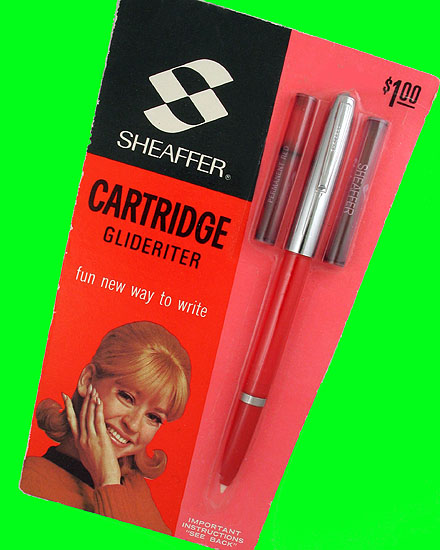
Sheaffer first used the Glideriter brand in 1966 and applied it as a brand to three fiber tip pens, the TwinWell, the Cartridge Glideriter, and the Stylist Glideriter.
The Cartridge Glideriter is essentially a standard Sheaffer Cartridge pen with a plastic fiber core feed and tip section. It has a slip on cap and was as simple and straightforward to use as the standard cartridge pens. Early versions of this pen are packaged as Stylpoint Writer pens.
Identification guide and features:
- Polished chrome plated cap with engraved spaced parallel lines
- Plastic barrel and section in solid colors: blue, black, red, and green
- Polished chrome plated ear clip stamped "SHEAFFER"
- Polished 1/4 inch chrome plated trim ring on section
- Plastic fiber tip point, single width, essentially a medium point
- Cap pulls off
- Refillable, uses Sheaffer Skrip cartridges
- About 5 inches long capped and 5 7/8 inches with the cap posted on the end of the barrel
- Weighs .5 ounce
- Sold on blister cards
- Retail price was US $1.00 with two Skrip cartridges included
- Replacement fiber tip front ends sold for $.50
Stylist Glideriter
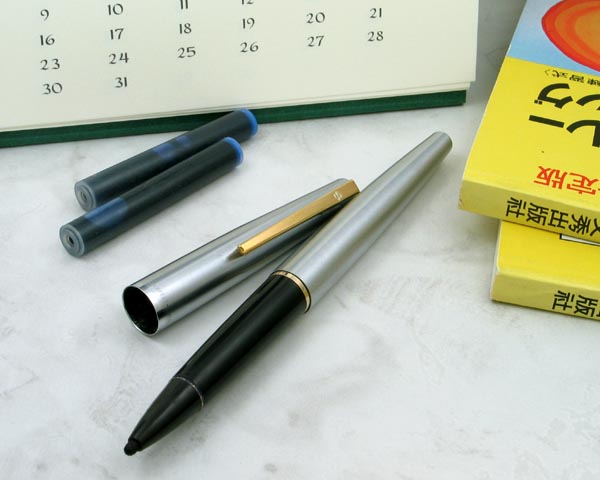
The Stylist Glideriter was the upscale version of the pen. The Glideriter rounded out four choices in the Stylist line: the Push Button Fill Fountain Pen, ballpoint, pencil, and Glideriter. The Stylist Glideriter followed the design and trim available to the line, and had the same profile as the fountain pen. It has a slip on cap.
Identification guide and features:
- Model 404C - brushed chrome cap and barrel, and black section
- Model 404P - brushed chrome cap with Metallic Gray, Metallic Blue, or Black barrel and section
- Gold tone clothespin action clip stamped with a stylized and white filled "S" at the top
- Plastic fiber tip point, single width, essentially a medium point
- Cap pulls off
- Refillable, uses Sheaffer Skrip cartridges
- About 5 1/2 inches long capped and 5 7/8 inches with the cap posted on the end of the barrel
- Weighs .8 ounce
- Sold singly or in sets in leatherette cases
- Retail price was US $3.95 with two Skrip cartridges and push button converter included
- Replacement packs of fiber tips were $.50
TwinWell Glideriter

The TwinWell Glideriter was introduced in 1965 as a throw away plastic fiber tip pen with two reservoirs, one in the base, as expected, and one in the cap, to keep the tip moist when the pen was not in use. Sheaffer renamed this pen the TwinWell Glideriter in 1966, making three Glideriter marker pens across the Sheaffer line.
Identification guide and features:
- Plastic cap and barrel in solid color, only white is shown in advertisements
- Polished chrome plated ear clip
- Sheaffer logo printed under clip on cap and "SHEAFFER" printed on front of cap lip
- Foam Fineline tip, single width, essentially a fine point
- Cap pulls off
- Separate non-refillable ink reservoirs in cap and barrel
- About 5 inches long capped and 5 7/8 inches with the cap posted on the end of the barrel
- Weighs .6 ounce
- Sold on blister cards
- Retail price was US $.49 with choice of black, blue, red, yellow or green ink
Other Sheaffer Marker Pens
Smoothie

The Smoothie looks like the Cartridge Glideriter in almost every way, except that it has a much larger fiber tip and lacks the section trim ring. The Smoothie was refillable by replacing the barrel, which was made in the same color as the ink it contained. It also had replaceable tips, like the Glideriter. It was advertised as a marker, much like modern Sharpie pens.
Identification guide and features:
- Polished chrome plated cap with engraved spaced parallel lines
- Plastic barrel in solid colors that match the ink they contain: blue, black, red, green or yellow
- Polished chrome plated ear clip stamped "SHEAFFER"
- Replaceable felt Float-Tip nib units, three types available: blunt general purpose, chisel, and fine point
- Cap pulls off
- About 5 inches long capped and 5 7/8 inches with the cap posted on the end of the barrel
- Weighs .6 ounce
- Sold on blister cards
- Retail price was US $1.00 with choice of blue, black, red, green or yellow ink
- Replacement ink barrels retailed for $.39 each with blue, black, red, green or yellow ink
- Replacement Float-Tip nib units retailed for $.39 in a pack with all three types: blunt general purpose, chisel, and fine point
Soft Stroke Pen
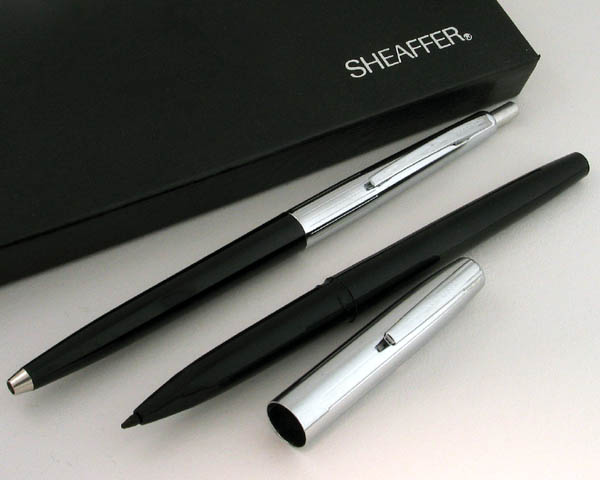
The throw away Soft Stroke Pen was introduced in 1969 and represents the last foray into the soft tip marker market by Sheaffer. The pen was offered singly, and interestingly paired in sets with refillable ballpoint pens and pencils. Once the Soft Stroke Pen ran out of ink, one would assume that it would be thrown away and replaced, though the pen or pencil would remain. To introduce the Soft Stroke Pen, Sheaffer offered to replace them free, with instructions on the back of the blister pack.
Sheaffer made all plastic versions of the Soft Stroke Pen and a the higher line version with a polished chrome cap similar to the Cartridge Glideriter. Although not branded as a Glideriter, it represents the endpoint of this thinking at Sheaffer. It's also notable in that Sheaffer marketed a metal cap pen as a throw away.
Identification guide and features:
- Two models: Polished chrome plated cap with engraved spaced parallel lines with plastic barrel and section in solid colors: blue, black, red, and green or Plastic cap, barrel, and section in solid colors: blue, black, red, and green with Sheaffer "S" logo at top of cap
- Polished chrome plated ear clip stamped "SHEAFFER"
- Foam tip point, single width, essentially a fine
- Non-refillable ink reservoir in barrel
- Cap pulls off
- About 5 1/4 inches long capped and 5 3/8 inches with the cap posted on the end of the barrel
- Weighs .5 ounce
- Sold on blister cards and in paperboard boxed sets
- Retail price of all plastic model was US $.49 with choice of blue, black, red, or green ink
Performance
Both of the Cartridge Glideriters I had available to try were still mint in their original blister packs. I actually wrote the article several months ago and was hanging on, hoping to finish the review by laying hands on a used one, though I wasn't sure if restarting a used fiber tip pen was going to be such a good thing. In three months I saw very, very few Glideriters, Cartridge or Stylist, offered on eBay and none anywhere else I looked. My guess is that most of these pens got tossed after use because of the eventual wearing out or hardening of the fiber tip, or from being replaced by throwaway pens like the Flair fiber tip pens that appeared later. I really hated to open one of these two mint pens in order to do a test, but I eventually gave up.
Blister packs are actually pretty easy to open without doing more than minimal damage to the card. If you ever want to do this, take a sharp knife and insert it, flat with the card stock, into the bottom edge of the plastic bubble. Cut around one of the longest sides of the plastic, going around slightly more than halfway at the top and bottom. If done carefully, the cut will be nearly invisible, and the blister will open like it's on a hinge. The pen will slip out easily, and can be replaced and secured with a small peel-off sticky tab.
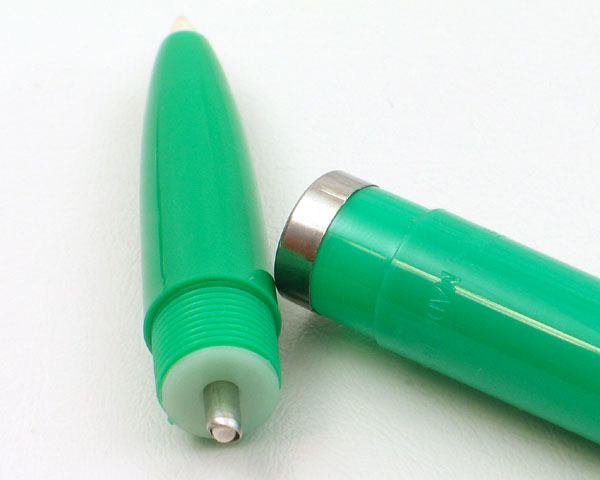
I selected the green pen as the tester because its card was in less than perfect shape as the red mint condition Cartridge Glideriter I had on hand.
The Cartridge Glideriter is basically the same cap and barrel as the cheapest mid-1960s Sheaffer Cartridge pen. It's average size, at 5 inches long capped and 5 7/8 inches posted. There are no innards to give this plastic and light metal cap any weight, so it's pretty light in the hand, capped or posted. If anything, the cap adds some length that makes the pen easier to handle for me, but it's balanced well either way, though quite short for large hands if not posted.
The fit and finish are good for a cheap pen, put there are no amenities. The cap slips onto three pips on the section trim ring. The section unscrews very smoothly, as expected on Sheaffer cheapies. The clip is an ear type, and very tight and with no give, and frankly, is a disappointment. I found it difficult to clip on and didn't like the snap I got trying to pull it out of my pocket. I worry that it might damage material over time. This is a thin shirt pen.
The Glideriter isn't exactly the sort of pen you can dip test. To work correctly, the tip needs to completely soak up ink from the cartridge. And since Sheaffer cartridge pens are the easiest of all to fill, I unscrewed the section, dropped in the cartridge, screwed the section back on, and waited.
Unlike other Sheaffer cartridge pens, the Glideriter takes a fairly long time to draw ink to the point. Looking at the section nipple, you can see the fiber tip material in the hole, indicating that the material likely extends all the way up to the tip, functioning as a kind of fiber feed. And a slow feed at that! It took twenty minutes with the point held downward before the tip darkened with ink.
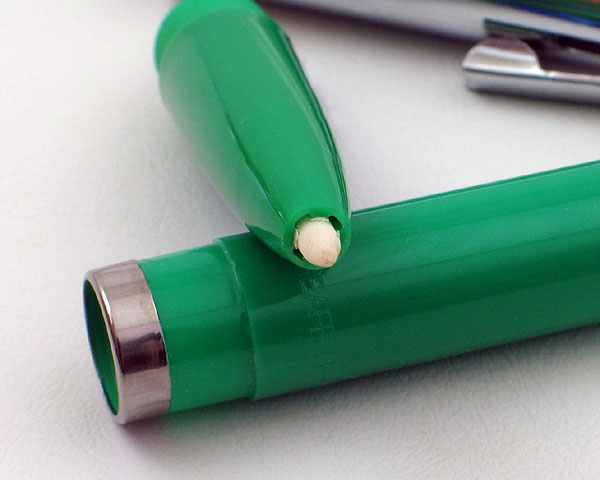
The Glideriter writes like most any other fiber tip. It's firm, but it has a little give or bounce, and it "talks" in little swishes on the page. It writes an impressively even line that's not too wet.
Because it uses fountain pen ink, I found the Glideriter will not do the work of a Sharpie, which will write on darn near anything. I had high hopes that I could replace the trusty Sharpies with my new green toy, but it was not to be.
Living with the Glideriter can be interesting. The closest thing to it is a Parker 61 Capillary Filler. I can attest to the fact that the pen can be flushed, but it takes a piston converter and lots of flushes to clear all the ink out of the fiber point and feed. A paper towel to wick out all the water and ink residue is necessary to finish the job.
Getting an old, already used Glideriter running again is another matter. Flushing alone will not dislodge the ink dried in the fiber matrix. Some 409 and soaking will get the unit somewhat clear, followed by a thorough flushing. A badly clogged tip unit will have to be replaced.
The Glideriter does, however, very nicely fit the bill for a refillable fiber tip pen. It's a great idea to be able to refill and change colors in a fiber tip pen. If the clip wasn't so unforgiving, I'd be sold on my new green friend. It works great, but the package doesn't grab me. Not exactly a priceless collectible, definitely not flashy, but a fun pen to use! I guess I'll be on the lookout now for a Stylist Glideriter!
Editor's Note:
I am pleased to report that I did finally acquire a Sheaffer Stylist Foursome set in brushed chrome that includes a Stylist Glideriter. It's a really nice set, and now that I have it I can't say I have that same far away look that the girl in the 1967 ad does. It's obviously not the pens!
Interact
Comments on this article may be sent to the author, Jim Mamoulides


